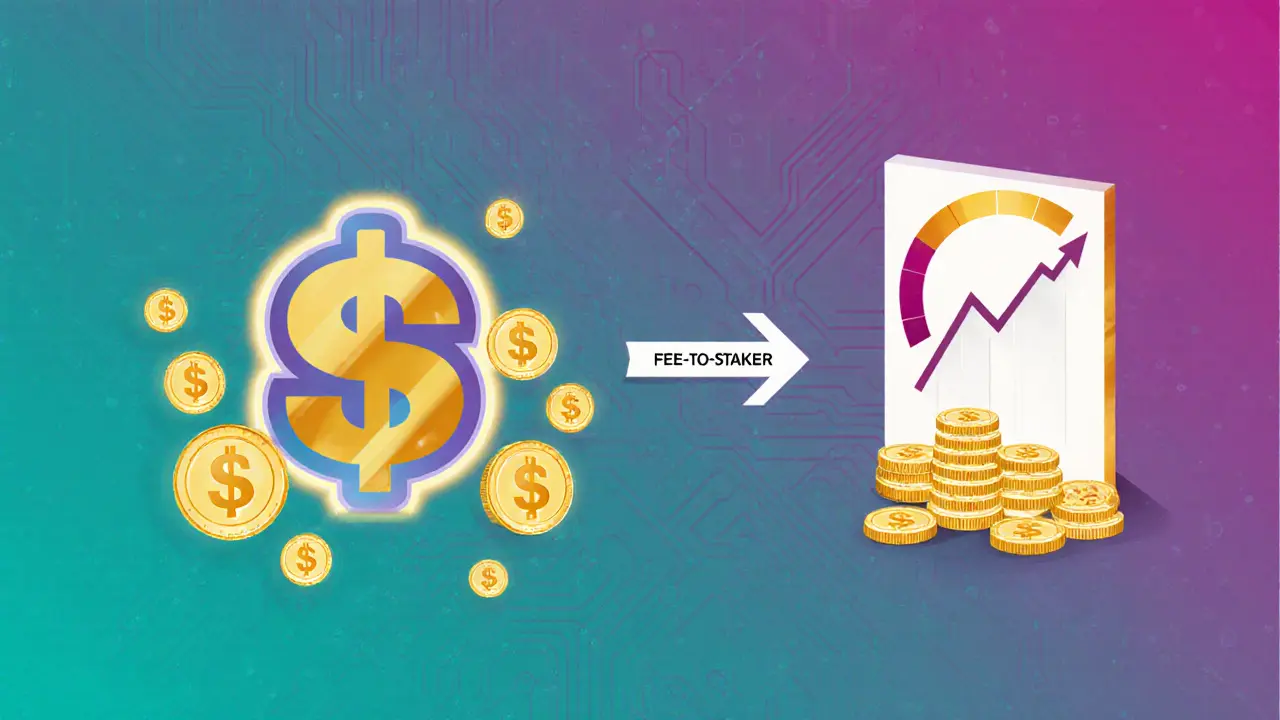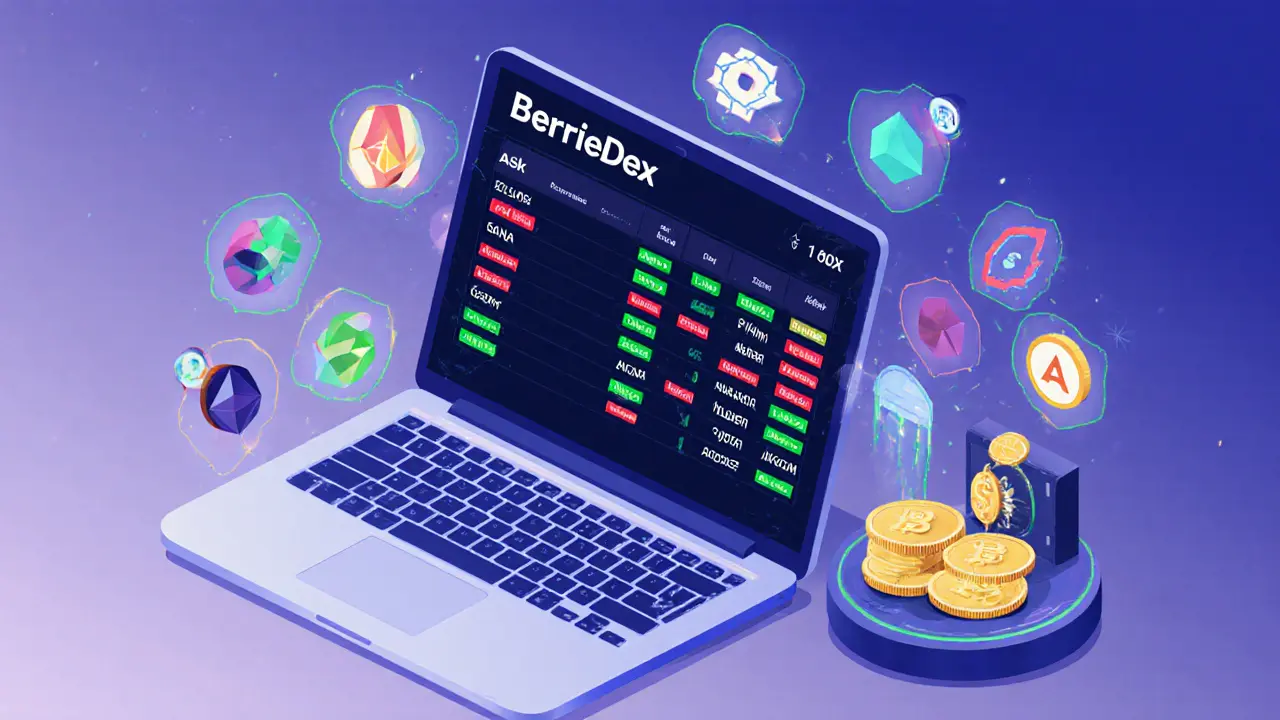BERRIE Staking Reward Calculator
Staking Reward Estimator
Estimated Daily Rewards
BERRIE Tokens Earned
USD Value
Based on current data (total supply: 10,000,000 tokens)
When you hear the name BerrieDex is a cross‑chain, order‑book decentralized exchange (DEX) that runs on multiple blockchains including Solana and Ethereum, you probably wonder what makes it different from the usual swap‑style platforms. In short, BerrieDex lets you place limit and market orders across nine networks without wrapping or bridging assets, and it rewards every trader by converting 100% of the platform fees into its native BERRIE token. This article walks through the core features, tokenomics, market data, and the biggest red flags you should watch before dipping a toe into the ecosystem.
Core Features of BerrieDex
At its heart, BerrieDex is built around an order‑book model rather than the automated market maker (AMM) approach most DeFi novices know from Uniswap or PancakeSwap. The order book lets you set precise entry and exit points, similar to a traditional crypto exchange, but the platform does it in a non‑custodial, decentralized way. Here are the headline capabilities:
- Multi‑chain support: Ethereum, BNB Chain, Solana, Arbitrum, Optimism, Avalanche, Polygon, Base and Algorand are all live, which means you can trade assets on any of these networks from a single UI.
- No wrapping or bridging: BerrieDex claims that assets stay on their native chain, eliminating the extra gas costs and security risks that come with bridge contracts.
- Professional‑grade order types: Limit orders, market orders, stop‑loss, and even advanced order‑book features such as iceberg orders are available.
- Fee‑to‑staker model: Every transaction fee is automatically swapped for $BERRIE and distributed to token stakers, which the team calls “real yield.”
That fee‑to‑staker design is the biggest selling point, but it also raises questions about sustainability-especially when the platform’s volume is still tiny compared with the DeFi giants.
Tokenomics: How $BERRIE Generates Yield
The $BERRIE token lives on the Solana blockchain under contract address mntAk89WGn1YacVFxzU84tVbn3zFYf1LVXMxMjhpTjC. The total supply is capped at 10,000,000 tokens, and according to the official whitepaper the entire supply will eventually be in the hands of stakers because the platform never mints new tokens beyond the original amount.
Every time a user trades on BerrieDex, a small fee (typically 0.2%‑0.3% depending on the market) is taken. Rather than sending the fee to a treasury, the protocol runs an on‑chain market order that buys $BERRIE tokens from the open market. Those purchased tokens are then proportionally allocated to anyone who has locked $BERRIE in the staking contract.
In theory, this creates a continuous upward pressure on price: the more you trade, the more $BERRIE is bought, and the higher the reward pool grows. In practice, the model hinges on two variables:
- Trading volume: Low volume means fewer fees and therefore less buying pressure.
- Liquidity of $BERRIE: If the token can’t be bought in large amounts without slippage, the fee‑conversion process could become inefficient.
As of October 2025, the token still shows a circulating supply of 0 on most trackers, suggesting that the staking contract hasn’t yet distributed any tokens or that the distribution data isn’t being reported correctly. That discrepancy is a major warning sign for potential investors.
Technical Specs & Supported Chains
BerrieDex’s architecture relies on a series of cross‑chain adapters that read order‑book data from each supported network and present a unified view. The platform’s documentation states that it uses a hybrid of on‑chain order matching (for Solana and Avalanche) and off‑chain order aggregation (for EVM‑compatible chains). While this approach can deliver faster order execution, it also introduces a surface area for bugs, especially when keeping state in sync across heterogeneous blockchains.
Here’s a quick snapshot of the nine networks currently live on BerrieDex:
- Ethereum (EVM)
- BNB Chain (EVM)
- Solana (high‑throughput)
- Arbitrum (Layer‑2)
- Optimism (Layer‑2)
- Avalanche (C‑Chain)
- Polygon (EVM)
- Base (EVM)
- Algorand (Pure‑Proof‑Of‑Stake)
Because each chain has its own fee model, users need to manage gas separately for every transaction, which can get confusing for newcomers. The platform does not yet provide a unified gas‑fee estimator, so you’ll often have to check each network’s explorer (e.g., Etherscan, Solscan) before confirming an order.

Market Performance & Pricing Discrepancies
Price data for $BERRIE is scattered across a handful of exchanges. On October 15, 2023 the following figures were reported:
- CoinMarketCap: $3.15 USD (24h volume $5,387.43)
- Binance price tracker: $2.95 USD (not listed for trading)
- Phemex: $4.58 USD (24h volume $518,978.99)
- Crypto.com: $3.01 USD (24h volume $2,333)
The spread is massive-over $1 between the lowest and highest quoted price. Such gaps typically hint at low liquidity, which indeed matches the reported total value locked (TVL) of roughly $18,420 across all pools. The limited number of markets also means that any sizable order can swing the price dramatically.
Because the circulating supply is officially zero, market‑cap figures all read $0, further underscoring that the token is still in an early distribution phase. Until the staking contract starts unlocking $BERRIE, price discovery will remain extremely volatile.
How BerrieDex Stacks Up Against Established DEXs
To put the platform in perspective, let’s compare a few key metrics with the leading order‑book and AMM DEXs. The table below uses publicly available data as of October 2025.
| Exchange | Primary Model | Chains Supported | 24h Volume (USD) | Fee Redistribution |
|---|---|---|---|---|
| BerrieDex | Order‑book | 9 (incl. Solana, Ethereum) | ~$520K (Phemex) | 100% to $BERRIE stakers |
| Uniswap v3 | AMM | 1 (Ethereum + L2s) | $1.1B (daily) | None (protocol fees to treasury) |
| PancakeSwap | AMM | 1 (BNB Chain) | $250M (daily) | Partial to CAKE holders |
| Raydium | AMM + order‑book hybrid | 1 (Solana) | $45M (daily) | Partial to RAY stakers |
The numbers make it clear: BerrieDex’s volume is a drop in the bucket compared with the market leaders. Its unique fee‑to‑staker model is appealing, but the ecosystem lacks the depth and user base that make yield sustainable at scale.
Risks, Criticisms & Red Flags
Every new DeFi project carries risk, but a handful of issues appear repeatedly in community chatter and analyst reports:
- Zero circulating supply: Reporting a 0 supply while showing active trading pairs suggests that token distribution isn’t transparent. Auditors typically flag this as a potential “rug‑pull” precursor.
- Lack of audited contracts: The team has not published a formal third‑party audit, and security researchers on Twitter have highlighted the absence as a major concern.
- Liquidity fragmentation: With only three active pools and a combined TVL under $20K, any large trade will cause noticeable price impact.
- Regulatory exposure: The SEC’s 2023 guidance on yield‑bearing tokens could classify $BERRIE as a security, meaning future legal action might freeze or restrict the token.
- Developer opacity: The project’s code repository is private, and roadmap updates have been scarce since the announced Q42023 mainnet launch.
These factors collectively push BerrieDex into the “high risk” bucket for most institutional investors. If you decide to experiment, treat any funds as “scratch‑paper money” that you can afford to lose.

Getting Started: A Quick How‑To Guide
If you’re still curious enough to try BerrieDex, here’s a step‑by‑step checklist that cuts through the noise:
- Create a wallet compatible with Solana and EVM chains: Phantom works for Solana; MetaMask covers Ethereum, BNB Chain, Polygon, etc.
- Fund the wallet: Deposit SOL for Solana fees and ETH/BNB for the other networks.
- Visit the official site: Navigate to
https://berr.ieand click “Launch DEX.” The page loads a single‑page app that prompts you to connect your wallet. - Select a market: Choose a pair like
USDC/SOLfrom the drop‑down. The order‑book will appear with current bids and asks. - Place a limit order: Enter the price you want, the amount, and confirm the transaction. Your order sits on‑chain until it matches.
- Stake $BERRIE for yield: After the token distribution begins, go to the “Staking” tab, lock your $BERRIE, and watch the reward meter grow.
- Monitor fees and rewards: The dashboard shows the total fees collected and the amount allocated to stakers each day.
Remember that transaction failures are common-reports indicate a 30%‑plus failure rate on Solana orders during peak times. Keep a small reserve of native gas tokens to retry if needed.
Bottom Line
BerrieDex tries to blend the precision of a traditional order book with the non‑custodial ethos of DeFi. Its Berrie Dex tokenomics sound promising on paper, but the platform is still battling low liquidity, opaque token distribution, and a lack of independent security audits. For seasoned traders who enjoy hunting for under‑the‑radar opportunities, it could be an experimental playground. For most users, especially those looking for stable yields, the risk outweighs the potential reward.
Frequently Asked Questions
What blockchain does the $BERRIE token run on?
$BERRIE is a native token on the Solana blockchain, using contract address mntAk89WGn1YacVFxzU84tVbn3zFYf1LVXMxMjhpTjC.
How are trading fees distributed on BerrieDex?
Every fee collected (typically 0.2‑0.3%) is automatically swapped for $BERRIE on the open market, then proportionally allocated to all users who have staked $BERRIE tokens.
Is BerrieDex audited?
As of October 2025, the project has not published a third‑party security audit. The lack of an audit is frequently cited as a major red flag.
Can I trade on BerrieDex without wrapping assets?
Yes. BerrieDex claims to keep assets on their native chain, so you don’t need to wrap tokens or use cross‑chain bridges to place orders.
What are the biggest risks of using BerrieDex?
Key risks include zero circulating supply, thin liquidity, no public audit, possible regulatory classification as a security, and frequent transaction failures on some chains.


Author
Ronan Caverly
I'm a blockchain analyst and market strategist bridging crypto and equities. I research protocols, decode tokenomics, and track exchange flows to spot risk and opportunity. I invest privately and advise fintech teams on go-to-market and compliance-aware growth. I also publish weekly insights to help retail and funds navigate digital asset cycles.